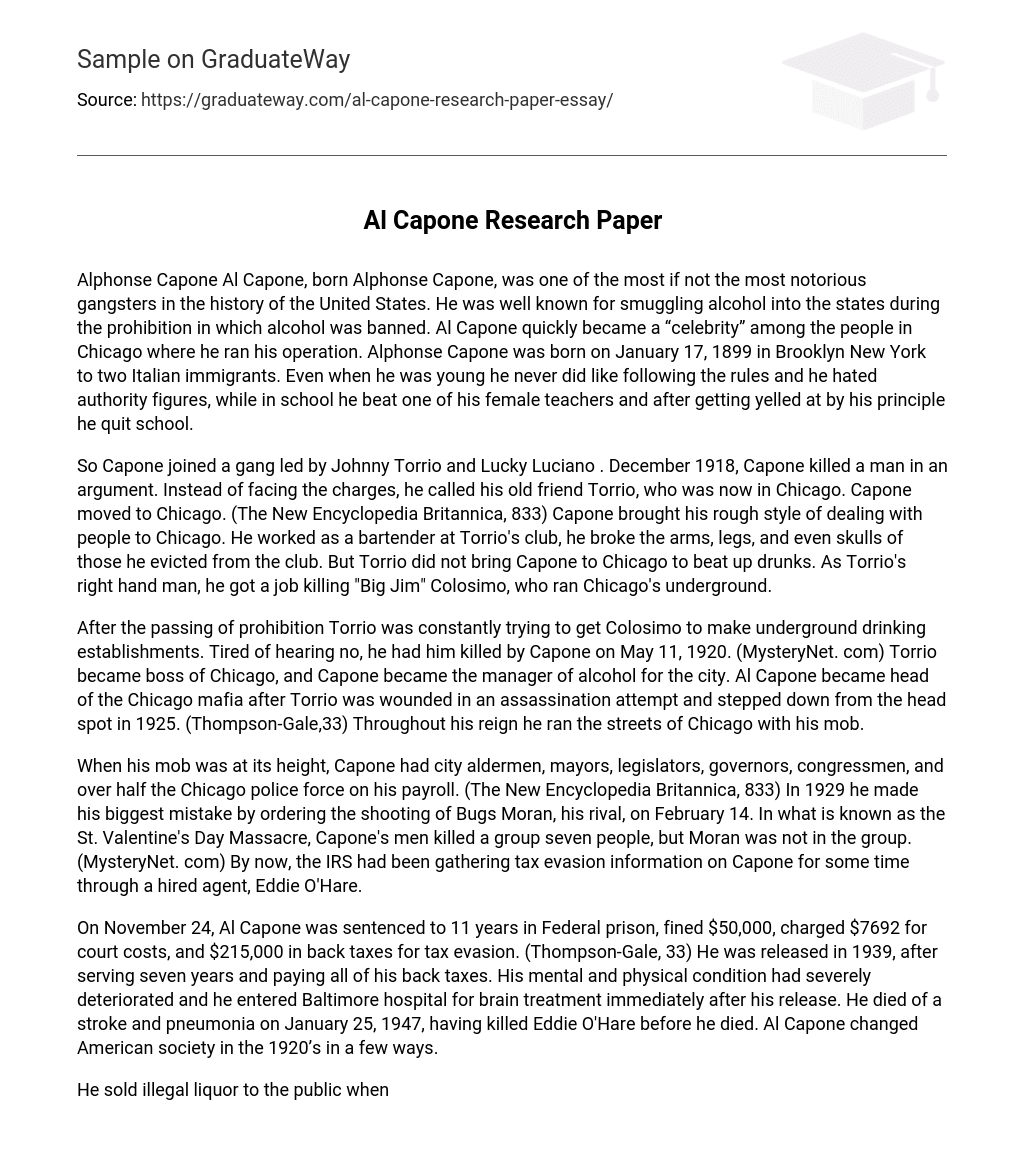Alphonse Capone, better known as Al Capone, was a notorious gangster in the United States. He gained fame for his involvement in smuggling alcohol during the prohibition era when alcoholic beverages were prohibited. Capone’s criminal activities made him a prominent figure in Chicago, where he operated. Born on January 17, 1899, in Brooklyn, New York to Italian immigrant parents, Alphonse Capone had a rebellious nature from an early age and showed disrespect towards authority figures. He even physically assaulted one of his female teachers and eventually dropped out of school after being punished by the principal.
Capone joined a gang led by Johnny Torrio and Lucky Luciano and in December 1918, he killed a man during an argument. Instead of facing the charges, he sought help from his friend Torrio, who had relocated to Chicago. Consequently, Capone moved to Chicago. (The New Encyclopedia Britannica, 833) In Chicago, Capone introduced his aggressive approach to dealing with people and started working as a bartender at Torrio’s club. He would inflict serious injuries on individuals he expelled from the club, breaking their arms, legs, and even skulls. However, Torrio did not bring Capone to Chicago solely for this purpose. As Torrio’s right-hand man, Capone was tasked with assassinating “Big Jim” Colosimo, the leader of Chicago’s underground activities.
After the Prohibition era, Torrio persistently urged Colosimo to establish illicit drinking venues. Growing weary of constant refusal, Torrio arranged for Capone to kill him on May 11, 1920. (MysteryNet.com) As a result, Torrio assumed control over Chicago, while Capone took charge of the city’s alcohol operations. When Torrio was wounded in an assassination attempt and resigned from his leadership position in 1925, Capone emerged as the head of the Chicago mafia. (Thompson-Gale,33) Throughout his rule, he commanded the streets of Chicago alongside his mob.
Capone’s influence extended to various political figures such as city aldermen, mayors, legislators, governors, congressmen and even more than half of the Chicago police force during his heyday. This information is recorded in The New Encyclopedia Britannica (833). In a significant mistake in 1929, he gave instructions to have his rival Bugs Moran shot on February 14th, resulting in what is famously known as the St. Valentine’s Day Massacre. Capone’s associates killed seven individuals during this event; however, Moran himself was not among them according to MysteryNet.com. By this time, the Internal Revenue Service (IRS) had been gathering evidence of tax evasion committed by Capone with assistance from their agent Eddie O’Hare.
On November 24, Al Capone was sentenced to 11 years in Federal prison and fined $50,000. He also had to pay $7,692 for court costs and $215,000 in back taxes due to his tax evasion (Thompson-Gale, 33). After serving seven years in prison and settling his overdue taxes, he was released in 1939. However, his physical and mental health had deteriorated greatly by then. Consequently, he immediately sought brain treatment at a Baltimore hospital. Unfortunately, Al Capone passed away on January 25, 1947, after suffering from a stroke and pneumonia. It is important to note that before his death, he had already committed the murder of Eddie O’Hare. In summary, during the 1920s Al Capone played a significant role in shaping American society.
Al Capone’s legacy will always be remembered as he sold illegal liquor to the public when they were in desperate need of it, demonstrating the immense power of ordinary people united for a common cause, even though it was illegal and resulted in numerous deaths.
Bibliography
- Thompson-Gale, Tom Pendergast and Sara Pendergast, editors. 2003 The New Encyclopedia Britannica, Volume
- Jacob E. Safra, Chairman of the Board, Encyclopedia Britannica, Inc MysteryNet. com, Mystery. Net, and TheCase. com are trademarks of MysteryNet. © 1998, 2009 MysteryNet and Newfront Productions, Inc.





